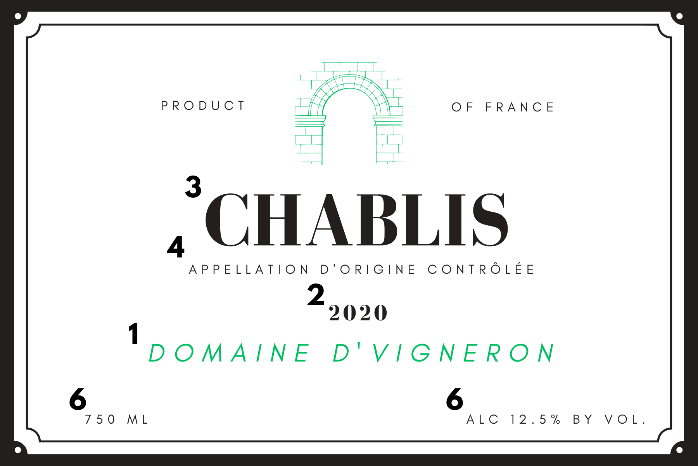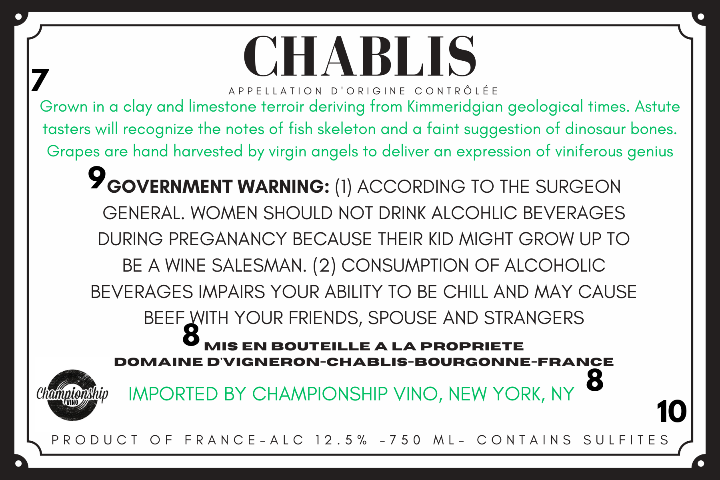Whether facing a wall of wine at the box store, the museum quality display of a tiny wine shop or the endless scroll of an online retailer, you’d be forgiven for thinking that every label is different. This is literally by design. How often have you heard someone say, or said yourself, one or more of the following? “I picked this wine because the label… looked expensive, fancy, serious, fun, had a critter on it” Wineries know this and devote a great deal of time and money to their label. Extensive research confirms that appealing to our base aesthetic impulses makes bottles jump off the physical or virtual shelf and into our cart.
There is, however, a way to avoid this trap. To deny the allure of appearances and make an informed decision. Despite their obvious and intentional differences, there are many ways in which all wine labels are the same. Recognizing and understanding these key elements provides valuable clues as to what’s inside the bottle, which is what really counts.
Let’s start with the terms that are REQUIRED on the label of all wine sold in the US, regardless of country of origin.
Front Label
Domestic

Imported

Producer/Wine Name (1) & Vintage (2)
“Producer” is typically the name of an individual, winery or brand.
“Wine Name” is a proprietary or whimsical name. (“The Prisoner” for example). In this instance, the producer’s name is on the back.
“Vintage” is the year in which the grapes grew (or were harvested in the Southern Hemisphere). Although climates in the major wine growing regions are relatively stable, variations from year to year still impact the resulting wine, necessitating this indication. In some cases, most commonly with sparkling wines, the wine is not from a single vintage but from a blend of several. In this case, “NV” (for Non-Vintage) is used.
Region (3)
This is where the grapes from which the wine was produced were grown. Legally defined and regulated in all wine producing countries. The initials (4) next to the place name– AOC, AOP, DOC, DO, AVA, etc – reference the classification system of that particular country.
Variety (5)
The type of grape used to produce the wine. Most regions require that a wine include a minimum of 75% of a variety for that variety’s name to appear on the front label.
Sharp-eyed readers will notice that there is no variety displayed on the front label of the Imported label. This is because in these countries the Region regulations extend beyond location to include what varieties are allowed to be grown there. For example, the label above is for a wine from “Chablis”, a region in France where the only allowable variety is chardonnay. Therefore, the thinking goes, including the variety name on the label is unnecessary.
ABV & Volume (6)
Expressed in % by volume and liters (.750 for example) or milliliters (750). Required by law in all wine producing regions. Can be on the front or back label.
Back Label
Domestic

Imported

Winery Blurb (7)
Meant to entice with a description of the wine and/or winery. Sometimes includes technical information or food pairing recommendations.
Name and Address (8)
- Domestic Wines:
- Indicates who Produced/Vinted/Cellared/Bottled the wine
- May be multiple names or addresses.
- Imported Wines:
- Indicates who imports to the US and their principle location of business.
Health warning (9) and Sulfite declaration (10)
Government mandating warning on the potential risks of alcohol consumption. Other countries have a similar, if differently worded or displayed, requirement.
The sulfite declaration applies to wines that contain more than 10ppm total SO2.
Until recently this was unique to the US but as of December 2023, all wine EU wines must carry a similar disclosure.
There you have it, ten ties that unite all wine labels. Sturdy, reliable guideposts on the path towards our goal of informed decision. There are only a few more points to clarify and terms to define. First, there are a few non-required label components that do come with certain requirements.
Certifications
Organic
Governed in the US by the USDA, two different indications:
- “Made with Organic Grapes”: looks and sounds somewhat unofficial but is a fully regulated label term. Indicates exactly what it sounds like. The wine is made from grapes grown in vineyards that are Certified Organic by the USDA.
- “Organic Wine”: carries the USDA seal.
Grapes come from Certified Organic vineyards and wine is produced with only Certified Organic yeasts, fining agents, etc in a USDA Certified Organic facility. Other production regulations also apply.
Biodynamic
- Refers to a complex system of wholistic farming practices. Regulation and certification in the US and other countries is done by multiple independent organizations, the name of which is usually on the label as well. For example, “Certified Biodynamic by Demeter”.
Regional Organizations
In the US there are several relatively small, hyperlocal coalitions of wineries that have drawn up, and agreed to follow, a code of conduct and sustainable practices relevant to their particular areas. Examples in California and Oregon include LIVE, Lodi Rules & Salmon Safe. Certified adherence to the respective by-laws is indicated by a seal on the back label.
In the Italian region of Chianti, a consortium was formed in 1924 to counter perceived dilution of the area’s reputation. This group chose the Gallo Nero (Black Rooster) as their emblem and indicates their commitment to high quality with a band label on the neck of their bottles.
The following label terms are not universal but extremely common and therefore merit explanation:
Estate
Legally defined in the US as a wine produced exclusively from vineyards owned by the winery. The terms “Mis en Bouteille” (France), “Azienda Agricole” (Italy) , “Vino de Pago” (Spain) and “Erzeugerabfüllung” (Germany) indicate the same.
Old Vine (also: vielles vigne – France & alta ruben – Germany)
Found on wines made from grapes grown on older than average vines. Typical qualifying vine age is more than 50 years, but neither consistent nor legally defined.
Reserve
Suggests some degree of grape/vineyard/barrel selection but, in practice, widely and inconsistently applied. Important exceptions are certain regions of Spain and Italy, notably Rioja and Barolo respectively. In these countries the term is legally defined with regards to minimum aging requirements.
Classico
Often seen on Italian labels and occasionally in conjunction with “Reserve”. It designates the historic center of a specific region (Chianti for example).
Ok, pay-off time. We’ve explained what all these terms mean, but why are they important and how can they help you make better buying decisions? Let’s start with some sure-thing, can’t miss strategies related to a few of required parts of all wine labels.
Producer/Wine Name & Vintage:
If you know and trust the producer, you likely don’t need to decode the rest of the label. If you don’t, no worries, read on.
There are few stone-cold locks here but one thing is for sure; the quality is inversely proportional to the cheesiness/overt pandering of the brand name. Best practice, but not fool-proof, is to pick wines with actual producer names. For more on this see Name & Address below.
As for vintage, it is very difficult to generalize except to recommend avoiding very old (5-10 yrs) wine.
Importer:
The single most reliable guide to choosing imported wines. In the 70’s Kermit Lynch established the model of importer-as-curator and paved the way for many, many others. Some, like Skurnik, Dressner, Rosenthal, or Solomon represent a range of countries and styles. Others, like Rudi Wiess and Becky Wasserman, go deep in just one country or region. Get to know them and their peers and seek out their offerings. Even when you don’t know or recognize the name on the front label, their name on the back is a guaranteed mark of quality.
Region:
Legally defined growing regions can range in size from an entire country to a single vineyard. In general, avoid broad non-specific designations as the grapes can come from a wide range of sites with varying degrees of quality and oversight. The rule of thumb is the more specific, and smaller, the designation the higher quality the wine. Take three Chardonnays from the US. The one labeled “Sonoma” is going to be better than the one labeled “California”, but not as good as the one labeled “Russian River Valley”.
Name/Address:
This is a bit of a sleeper and not necessarily a deal breaker. Red flags fly if the name of the producer/vintner/bottler on the back label doesn’t match the producer name on the front label. Ditto the region on the front and address on the back. There are many reasons why this may be. None of them are endorsements of quality but neither are they necessarily incompatible with it. Just proceed with caution. However, if there are multiple different producer/vintner/bottlers listed, set the bottle down and back away.
Finally, let’s look at those common, non-required label terms and how they do, or don’t, inform your decision:
Estate et. al.
A reliable indicator of quality. Related to Region and Name/Address. An Estate wine benefits from a smaller, well located, well managed vineyard site, an optimal combination of factors.
Classico
Also a high correlation with quality. The vineyards in these areas are at the core of the esteemed reputations of their larger regions. They occupy the best sites and the most historic precedent, a killer combination
Old Vine
When accurate, a strong suggestion of a wine’s style, if not necessarily it’s quality.
Reserve
Aside from the exceptions discussed in Italy and Spain, completely useless as an indicator of quality.
As it turns out, wine labels are not as big a mystery as it seems. In all the important ways, the ways that lead to you drinking better, they are more similar than they are different. Knowledge is power and now you have the power to stand in front of that wall and not be bowed.


